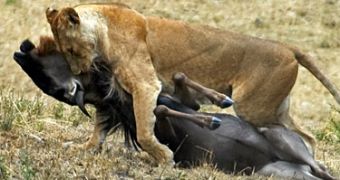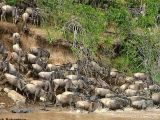This is the main character of all documentaries made on the savanna. We like to watch lions, hyenas or wild dogs hunting and in most cases they hunt wildebeests. That's because this is the most common African antelope of the savanna.
Today wildebeests live only in eastern/southern Africa, but 300-400,000 years ago, when Sahara was a bushy savanna, they were also abundant in this area. 10,000 years ago, wildebeests were still present in North Africa. In fact, wildebeests ancestor, Oreonager tournieri, appeared 3 million years ago in Algeria. 2 million years ago, the modern wildebeest genus, Connochaetes, appeared. One million years ago, the lineage of the two modern wildebeest species split.
Fossils of Connochaetes taurinus olduvaiensis were found in Tanzania. This antelope could have been hunted by the early humans and led to the blue wildebeest (C taurinus) you see in the documentaries made in eastern Africa. The black wildebeest (C gnou) evolved in southern Africa from C. africanus. The black wildebeest had two breeds: laticornus (extinct) and antiquus (actual) which differed only by horn shape.
A wildebeest grazes on 3.12 (7 pounds) of grass in dry weight daily, of which it digest 82% (much more than cattle or other herbivorous mammals). This explains why wildebeests grow by 200 grams per day (efficiency 41%) compared to 136 grams per day (efficiency 32.5%) in the case of the African cattle.
Wildebeests also consume succulent plants and tree leaves. They can resist without water for 2-5 days, but their density drops to 14 animals per square km (35 per square mi) at a distance of 5 km (3.2 mi) from a water point, as wildebeests are more water dependent than other animals of the savanna.
The births take place during the rainy season. The calf stands on its feet 5 minutes after being born. After birth period, the breeding period follows, and a male defends a territory comprising a harem made of 2-50 females and their calves.
The blue wildebeests make the famous 1,500 km (920 mi) migration southward for breeding in December-May. About 1 million individuals are involved in this migration. They move back northward for August -November, towards the Lake Victoria. Many wildebeests die during this trip that involves crossing the Mara River, in mass drowning events. The black wildebeest of southern Africa is less migrant. A migrating herd is led by an older female. The wildebeests are accompanied in their migrations by zebras and gazelles. Female wildebeest with calves prefer to make shorter migrations to areas where the soil has a balance in magnesium, sodium, phosphorus and calcium, while males and other females are less sensitive to this issue further to the north, where pastures can be unbalanced.
37% of the wildebeests are killed by predators, 16% die because of the accidents, and 47% because of the bovine pest. Isolated wildebeests risk to be attacked since they make 47% of the lion's diet (a lion eats 36 wildebeests annually). 90% of the hunted wildebeests are killed by lions. That's why there are migrant lion bands that follow the wildebeests in their migrations, while the resident lions starve until the return of the local wildebeests.
Cheetahs can kill calves younger than 2 months and on rare occasions, an adult, if they form a group. An African wild dog can kill a wildebeest in 8 minutes.
95% of the wildebeest cows give birth annually (only 50-60% in the case of domestic cattle). A wildebeest cow gives birth to 10 calves during her lifespan, and the herds grow by 10% annually as 15-50% of the calves are killed by predators.
The bovine pest has been introduced in the African savanna by the European cattle and is transmitted through water sources. In Botswana, wildebeests transmit aphthous fever to the domestic cattle, that's why a 1,300 km (800 mi) barrier was built to impede wildebeests to come in contact with domestic cattle. This hinders their migration and the wildebeests are plummeted from 250,000 to 30,000, as the antelopes die of thirst.

 14 DAY TRIAL //
14 DAY TRIAL // 
